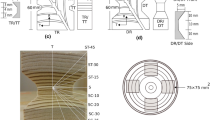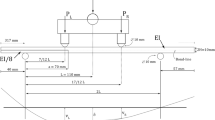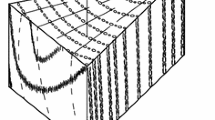Abstract
Many different phenomenological failure criteria have been proposed. These type of criteria do not explain the mechanism of failure itself. They merely identify failure (yes or no) and are usually regarded in practice as a simple and reliable tool for design. Most of them were developed for composite materials, but are extensively applied for wood. In this study, existing phenomenological strength criteria for orthotropic materials were applied to clear wood data. Instead of fitting the criteria to available experimental data, the criteria were used to predict failure of biaxial tests based on uniaxial strength. This procedure is closer to practice, and hence an answer to the question “is there any reliable failure criterion for wood?” Predictability of the criteria was assessed using normalisation procedure, and statistical significance of the difference of the means analysed. Based on the results, it can be concluded that a general criterion cannot be applied to predict failure, but should be chosen according to the biaxial stress state.
Zusammenfassung
In der Literatur werden viele verschiedene phänomenologische Versagenskriterien beschrieben, die jedoch nicht den Versagensmechanismus selber erklären, sondern nur den Bruch identifizieren (ja oder nein). In der Praxis werden diese Kriterien in der Regel als einfaches und zuverlässiges Werkzeug für die Bemessung angesehen. Die meisten der Kriterien wurden für Verbundwerkstoffe entwickelt, werden aber zunehmend auf Holz angewandt. In dieser Studie werden bestehende phänomenologische Versagenskriterien für orthotrope Werkstoffe auf fehlerfreies Holz angewendet. Das Modell wurde nicht an die vorhandenen Versuchswerte angepasst, sondern die Kriterien wurden dazu verwendet, um den Bruch von zweiaxialen Versuchen mittels einaxialen Festigkeitswerten zu bestimmen. Dieses Verfahren ist praxisnäher und liefert somit eine Antwort auf die Frage, „Gibt es ein zuverlässiges Versagenskriterium für Holz?“ Die Vorhersagbarkeit der Modelle wurde anhand normalisierter Abweichungen von den Versuchswerten und statistischer Signifikanz analysiert. Aus den Ergebnissen kann geschlossen werden, dass es für Holz kein allgemeines Versagenskriterium gibt, sondern nach dem Spannungszustand gewählt werden sollte.









Similar content being viewed by others
References
Aicher S, Klöck W (2001) Linear versus quadratic failure criteria for in-plane loaded wood based panels. Otto-Graff-Journal 12:187–199
Azzi VD, Tsai SW (1965) Anisotropic strength of composites. Exp Mech 5(9):283–288
Bodig J, Jayne BA (1982) Mechanics of wood and wood composites. Van Nostrand Reinhold, New York
Cabrero JM, Heiduschke A, Haller P (2010) Analytical assessment of the load carrying capacity of axially loaded wooden reinforced tubes. Compos Struct 92(12):2955–2965
Clouston PL, Lam F (2001) Computational modeling of strand-based wood composites. J Eng Mech 127(8):844–851
Cowin SC (1979) On the strength anisotropy of bone and wood. Transactions of the ASME. J Appl Mech 46(4):832–838
de Ruvo A, Carlsson L, Fellers C (1980) The biaxial strength of paper. Tappi 63(5):133–136
Eberhardsteiner J (2002) Mechanisches Verhalten von Fichtenholz. Springer, Vienna
Ehlbeck J, Hemmer K (1986) Erfassung, systematische Auswertung und Ermittlung von Grundlagen über das Zusammenwirken von Längs-, Quer- und Schubspannungen bei fehlerfreiem und fehlerbehaftetem Nadelholz. Forschungsvorhaben Nr. 5764. IRB Verlag, Stuttgart
Feiler M (2001) Experimentelle und numerische Untersuchungen an kraftflussgerechten Gelegen zur Verstärkung von stabförmigen Verbindungsmittel: Master’s thesis. Technische Universität Dresden, Germany
Gol’denblat I, Kopnov VA (1965) Strength of glass-reinforced plastics in the complex stress state. Polym Mech 1(2):54–59
Hankinson RL (1921) Investigation on crushing strength of spruce at varying angles of grain. Material Section Report, No. 130 259, Air service information circular, Vol. 3, No. 259, McCook Field, Dayton
Hemmer K (1984) Versagensarten des Holzes der Weisstanne (Abies alba) unter mehrachsiger Beanspruchung, PhD thesis. Karlsruhe
Hill R (1950) The mathematical theory of plasticity. Oxford University Press, London
Hinton MJ, Kaddour AS (2007) The second world wide failure exercise: benchmarking of failure criteria under triaxial stresses for fibre-reinforced polymer composites. In: 16th international conference on composite materials
Hinton MJ, Kaddour AS, Soden PD (eds) (2004a) Failure criteria in fiber reinforced polymer composites: the world-wide failure exercise. Elsevier, Amsterdam
Hinton MJ, Kaddour AS, Soden PD (eds) (2004b) The world-wide failure exercise: Its origin, concept and content. In: Failure criteria in fiber reinforced polymer composites: the world wide failure exercise. Elsevier, Amsterdam, pp 2–28
Hoffman O (1967) The brittle strength of orthotropic materials. J Compos Mater 1:200–206
Kaddour AS, Hinton MJ, Li S, Smith PA (2007) Damage theories for fibre-reinforced polymer composites: the third world-wide failure exercise (WWFE-III). In: 16th international conference on composite materials
Kasal B (1992) A nonlinear three-dimensional finite-element model of a light-frame wood structure: PhD thesis. Oregon State University, USA
Kasal B, Heiduschke A (2004) Radial reinforcement of curved laminated beams. Forest Prod J 54(1):74–79
Kasal B, Leichti RJ (2005) State of the art in multiaxial phenomenological failure criteria for wood members. Prog Struct Mat Eng 7:3–13
Kim D-H (1995) Composite structures for civil and architectural engineering. E & FN Spon Press, London
Malmeister AK (1966) Geometry of theories of strength. Polym Mech 2(4):324–331
Norris CB (1950) Strength of orthotropic materials subjected to combined stress. Technical Report 1816, U.S. Forest Products Laboratory
Rowlands RE (1985) Failure Mechanics of Composites, chapter Strength (failure) theories. In: Handbook of Composites, vol. 3. Elsevier Science Publishers, Amsterdam, pp 71–126
Rowlands RE, Gunderson DE, Suhling JC, Johnson MW (1985) Biaxial strength of paperboard predicted by hill-type theories. J Strain Anal 2:121–127
Smith I, Landis E, Gong M (2003) Fracture and fatigue in wood. Wiley, New York
Spengler R (1982) Ermittlung des Festigkeitsverhalten von Brettelementen aus Fichte unter zweiachsiger Beanspruchung durch Versuche. Technische Universität München: Berichte zur Zuverlässigkeitstheorie der Bauwerke, Heft 62, p 63
Suhling JC, Rowlands RE, Johnson MW, Gunderson DE (1985) Tensorial strength analysis of paperboard. Exp Mech 25(1):75–84
Tennyson RC, MacDonald D, Nanyaro AP (1978) Evaluation of the tensor polynomial failure criterion for composite materials. J Compos Mater 12:63–75
Tsai SW (1988) Composite Design. Think Composites, Dayton, 4 edn
Tsai SW (1992) Theory of composites design. Think Composites, Dayton
Van der Put TACM (2005) The tensor polynomial failure criterion for wood. Delft Wood Science Foundation, Delft
Von Mises R (1928) Mechanik der plastischen Formänderung von Kristallen. Angewandte Mathematik und Mechanik 8:161–185
Williams JM, Fridley KJ, Cofer WF, Falk RH (2000) Failure modeling of sawn lumber with a fastener hole. Finite Elem Anal Des 6:83–98
Wu EM (1972) Optimal experimental measurements of anisotropic failure tensors. J Compos Mater 6:472–489
Acknowledgments
The support provided by the PIUNA Research Program of the University of Navarra for this work is greatly acknowledged.
Author information
Authors and Affiliations
Corresponding author
Rights and permissions
About this article
Cite this article
Cabrero, J.M., Blanco, C., Gebremedhin, K.G. et al. Assessment of phenomenological failure criteria for wood. Eur. J. Wood Prod. 70, 871–882 (2012). https://doi.org/10.1007/s00107-012-0638-3
Received:
Published:
Issue Date:
DOI: https://doi.org/10.1007/s00107-012-0638-3




